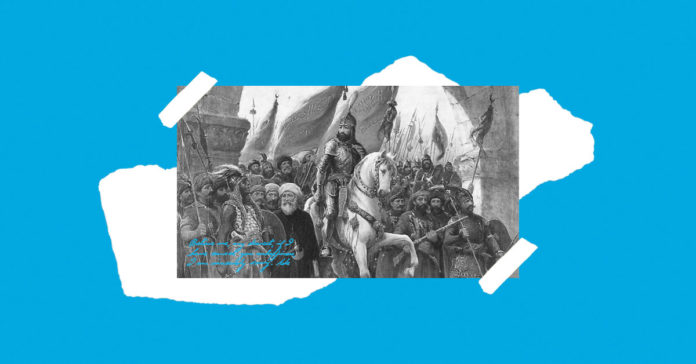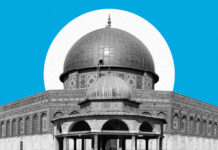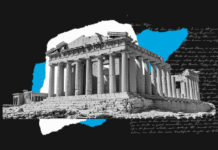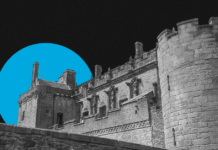…Western negative depictions of Muslims, throughout the centuries have only been given legitimacy and turned into truths by mere repetition, even though such depictions fundamentally contradict truth and reality. The same holds with respect to the Turks, which as Schwoebel, referring to renaissance images of the Turks, notes:
‘Accounts repeated over and over cannot for the most part have been distinguished for their accuracy and objectivity, especially where they involved Muslim affairs. Yet tales transmitted in this manner constituted a significant share of the common stock of Europe’s knowledge of the East; and in a society largely illiterate they weighed heavily in the formation of Western attitudes toward the Ottoman Turks. For countless common folk the returned pilgrim served as the single, direct link with the mysterious and frightening world of the Levant. His meagre fund of half truths regarding the Turks gave rise to exaggerated and bizarre concoctions among his fellow citizens.’[1]
Many Pilgrims and travellers, for instance, carried stories about the Turks, which in the main were neither complete nor accurate, and were further distorted as time and distance separated the story teller from his source.[2]
The persistent labelling of the Turks, whether the early Seljuks (10th-13th century) or the Ottomans (13th-20th century), as barbaric, cruel fiends and enemies of science and progress has no basis in reality, but has other motivations. With regard to the Seljuks, hostility to them, as to the Mamluks for that matter, derives from the simple fact that during the Western Christian onslaught on the Islamic lands in the crusades era (1095-1291), they were the main foes of the crusaders. Any person reading the history of the crusades, from Muslim or Christian sources, old or new, will realise this, and if it had not been for the Seljuk Turks, Muslims in their millions could have been totally exterminated.[3] As for the Ottomans, the same argument holds for, from the 13th until the early 20th century, they were the main Christian military foe, engaging Christendom on countless fronts.[4] It was the Ottomans, who, as history shows, protected the entire Muslim world from Western annihilation.[5] Thus, there is little surprise in coming across such vilification of the Ottomans, vilification which is amply noted by Fisher[6] and Davenport, who has also concluded that the Turks’ being the principal Islamic foe of the Christian West for centuries was the major reason for violent anti-Turkish rhetoric.[7] Galland (1646-1715) also earlier observed how the Turks were wrongly vilified: it suffices to name them to signify to Europeans a coarse, barbarous, thoroughly ignorant nation.[8]
The generally-held view that the Turks were intolerant and cruel to the Christians is contradicted by historical reality. In general, the Ottomans continued the policy of religious toleration which they had inherited from the Arabs, Glubb notes.[9] Othman (1281-1326), the founder of the Ottoman nation, gained the reputation of a ruler who might be safely followed, and under whose protection Christians found security both from other Turks and from the exactions of their own emperor.[10] Succeeding him, Orkhan (1326-1359) had to rule over large numbers of Christians, and many of the peasants from neighbouring territories sought his protection, for, as the Greek writers record, his Christian subjects were less taxed than those of the Empire.[11] He protected them, left them the use of their churches, and pursued a policy of reconciliation during all his reign.[12] Subsequently, Bertrandon de la Broquiere, who was sent by Philip of Burgundy East in 1432, travelled to study the situation with a view to the Crusade, and wrote his impressions.[13] Passing through Turkish territory and through Serbia, he noted prosperity and good cultivation of the land; and also noted that towns and cities have a mixed population of Greeks and Turks, the latter described as thrifty and clean and hardworking.[14]
When they reached the Orient after conquering the Balkans, the Ottomans strengthened confessional dialogue, allowing a revival, as unexpected as spectacular, of Arab Christianity.[15] As soon as they entered Constantinople, the Ottomans recognised the collective existence of religious minorities, instituting them into nations, giving them autonomy in religious matter, judicial, cultural, and health-care affairs.[16] The Ottomans sought the participation of their former enemies: officially Muslim, the Empire transformed itself, into a Greco-Turkish Diarchy which was to last until the rising and the independence of Greece (1821-1830).[17] During the reign of Suleyman the Magnificent, Christian villagers of Southern Greece preferred Turkish rule to that of the Venetians, and Christian villages in Hungary voluntarily chose Turkish government in preference to that of their fellow country-men.[18] In Istanbul, and in an Anatolia profoundly Islamised, the Christian and Jewish populations emerged again after the Islamisation of the previous f our centuries. Christianity experienced a revival from 8% in the census of 1520 and 1570, to 16% in the 19th century.[19] Around 1881 the non Muslim population, especially Greeks and Armenians, reached the peak of their growth. By that date, they made up 21% of the population in the territory of present-day Turkey.[20] The whole of the population of the Anatolian provinces increased between 1831 and 1881-93 at a rate of 15.7 per thousand per annum, but, as always in Ottoman history, the Christians grew more quickly (19 .8 per thousand) than the Muslims (15 per thousand).[21]
Under the Ottomans, Christian and Jewish religious authorities had the exclusive control of their cult, of schools and their judicial system.[22] Whilst for the Jews, it was amongst the Turks that they found not just acceptance, but even promotion and, more importantly for them, asylum after being persecuted elsewhere.[23] They were protected from Christians, too, for Jews could not even venture out on Easter in Athens.[24] Free from military service, the Christian and Jewish populations had far greater opportunities to be socially mobile, helped by the quasi-monopoly they maintained over the most dynamic sources of society and economy.[25] They kept this status during the whole period of the Ottoman Empire, down to the 20th century. ‘Their commercial genius gave them a virtual monopoly over commerce and a considerable share of the wealth of the country …. The talents of the Armenians were truly indispensable to his masters and the general tolerance which the Turk accorded him showed that this fact was recognised.’[26]
In relation to the supposed Turkish cruelties, once more reality on the ground contradicts the generally-held assumptions. Unlike the rhetoric which associates cruelty with Muslims, terrible deeds were instead the work of Western Christendom as here noted by F. Osborne, who spoke of the French massacre of the St Batholomew:
‘The foulness of which story bath not yet been matched by Mahumet or any of his disciples never found to have borne such bitter fruit.’[27]
To him, the Ottoman Government has far superior characteristics to the European monarchies of his age. He admires the system of meritocracy, administration of justice, and religious toleration – all of which make him believe that this is an incorruptible system.[28] De la Croix, an interpreter at Constantinople, witnessed none of the barbaric cruelty associated generally with the Ottomans.[29] In his unpublished Memoires, he recognised that the Ottomans allowed the same freedom of worship for Christians that they could find in France and that Christian ceremonies were not hindered by the Turks by any means. Equally, De La Croix was impressed by the treatment of slaves, noting that their spiritual needs were not at all neglected, benefiting from chapels inside the prisons where they could pray in all liberty. He even noticed three Roman Catholic churches,[30] and concluded that:
‘We should agree, it is better to fall into the hands of the worst Bey (Turk) galley, than into the hands of the Viceroy of Naples.’[31]
As Fisher notes:
‘The picture of a stem and ultimately triumphant struggle in the Levant and Mediterranean seas by a united Christendom against the relentless aggression of barbarous or semi barbarous Turks is clearly a fallacious one … [Contemporary] Christian peoples not only regarded the Turks as more civilized than the Spaniards and French, but even sought to place themselves under their protection and govemment,[32] while the Spaniards themselves appear to have regarded the Turks as honourable foes.[33] Kheir-eddin Barbarossa, who has, by some curious process, come to be depicted in our latest histories as an ‘infamous character’ and ‘professional pirate’, was in his own age reputed by Christians generally to be a wise statesman, an able administrator, and a great soldier, noted for his orderly and civilized conduct of war and courted in tum or simultaneously by the greatest princes, spiritual and temporal, of the Mediterranean. His career was the subject of intensive propaganda for political purposes, not only in his own lifetime but nearly three centuries later.’[34]
For centuries, to this day, the views about Turkish cruelties have ignored the real cruelties of which the Turks had been victims. Daniel notes how the late 19th-century British Prime Minister, Gladstone, for instance, was convinced of the substantial truth of the allegations against the Turkish soldiers. He entirely ignored those committed by the Bulgarians against the Muslim villagers and Jewish town populations, although these were apparently equally substantiated. It is hard not to conclude that Gladstone gave Christians the benefit of understanding and sympathy he denied to Muslims. The Turks he wrote:
‘Were, from the black day they entered Europe, the one great anti-human specimen of humanity.’[35]
In reality, the massacres, of Turkish populations in the Balkans in the wake of the decline of the Ottoman Empire are some of the most dreadful of European history.[36] Likewise, every single Turkish town or city that f ell to Christian armies was followed by the wholesale massacre of its population.[37]
Under the Ottomans, slaves, just like other citizens, had their rights, and uniquely in the whole history of slavery, it is even said that a slave might summon his master before the Qadi (judge) for ill usage.[38] It was also alleged that if their tempers were so opposite, that it was impossible for them to agree, the Qadi would oblige his master to sell him.[39] Captives who were held in households of private individuals, as Arnold notes, were no worse off than domestic servants in the rest of Europe.[40]
Moreover, according to Lybyer:
‘The Ottoman system deliberately took slaves and made them ministers of state; it took boys … and made them courtiers and the husbands of princesses; it took young men whose ancestors had borne the Christian name for centuries and made them r ulers in the greatest of Mohammedan states.’[41]
The majority of the Christian slaves who converted to Islam, as Arnold points out, changed their religion of their own free choice;[42] and ‘the Christian embassies were never sure from day to day that some of their f ellow countrymen that had accompanied them to Constantinople as domestic servants, might not turn Turk.’[43] Turkish lenient treatment was not just hidden away from opinion to maintain the demonic stature of the Turk; it was always regarded unfavourably as by Queen Elizabeth’s envoy, William Harborne.[44] And Delacroix, himself, did not forget his job as a diplomat, and hence saw such Turkish humanity as a fruit of political expediency; that somehow, by allowing slaves and prisoners freedom to trade and marry, it stopped them from seeking to escape.[45] Chevalier d’Arvieux, on the other hand, was not much appreciated for his account of Turkish humanity. His memoires were f iercely criticised in a treatise called Lettres Critiques d’Hadgy Mohammed Effe ndi attributed to Petis de la Croix,[46] which highlights the enduring hostile views of the Turks.
With regard to arts, learning and sciences, the Turkish contribution was very high. Far from causing the decline of Islamic civilization, the Turks in fact rescued it from collapse and gave it a new lease of life that lasted centuries longer.[47] The early Turks, under their various appellations, sponsored some of the greatest scholars of Islam such as al-Khazini, Omar Khayyam, al-Jazari, etc.[48] They also sponsored schools, madrasas, observatories, and built considerable numbers of scholarly institutions, besides promoting the study of all forms of sciences.[49] The skills and refinements the Turks passed to others, including to the Christian West, constitute the foundation of many of our modem aspects of civilization.[50] Turkish construction skills and techniques, for instance, opened new horizons for others to imitate from the middle ages down to the modem times.[51] Also, as Fisher writes:
‘Among the surprises that emerge from a perusal of Christian records and narratives of the sixteenth and seventeenth centuries are testimonials to the Turks as a highly civilized people, from both a moral and practical standpoint. Modem military science owes much to Turkish practices of those days, particularly in regard to engineering and the conduct of field operations, and also, perhaps, in connection with the discipline, training, and welfare of troops …. The unquestionable ability of the Turks to maintain law and order is the more unexpected in view of prevalent impressions of anarchy and bloodshed. In the eighteenth century Constantinople was said to be not only the largest city in Europe but the best policed.’[52]
With regard to Ottoman art, as Talbot Rice observes, it is wholly original, and distinct, owing in general little to Persia, and even if the ideas that were to form the basis of Ottoman architecture were adopted f rom Byzantium, the basic theme was so developed that almost at once it became a distinctive style.[53] Ottoman achievements in art and architecture, well detailed in some works, also defy the image of Turkish barbarism and enmity to culture, and photographic evidence disproves the countless inanities told about Ottoman ineptness or enmity to arts.[54]
Ottoman contributions to learning as a whole are considerable, and as Galland firmly believes, it is unjust to slander the Turks in this way, and he dismisses the idea that they were inferior to the Arabs and Persians in the sciences and literature common to these three nations. He maintains that they engaged in these pursuits almost from the beginning of the Empire, and that they have an unbroken succession of theologians and legal experts as well as historians.[55] Galland admires their prodigious quantity of books on Islamic theology, philosophy, physics, mathematics, history, treatises on rhetoric and grammar, poetry in Arabic, Persian and Turkish.[56] In a letter dated 25 February 1701 to P.D. Huet, former Bishop of Avranches, Galland expresses admiration for the way in which the Turks show their love of good books, spending considerable sums for the acquisition of manuscripts.[57] Galland is also struck by the existence of so many poets in Arabic, Turkish and Persian, apparently more numerous than those in other languages. He notices some 1,600 titles, which would occupy more than 2,000 volumes, dealing with Islamic history from the Hijra, the history of the great Muslim conquerors and the biographies of illustrious men in all professions.[58] Also writing in support of the Turks is another contemporary, Jean de Thevenot, nephew of Melchisedech Thevenot, one of the founders of the Academie des Sciences, who travelled through Turkey, Egypt, Iraq, and India, who describes the beautiful mosques of Istanbul, struck, as he was, by the fact that all these mosques had attached to them hospitals and schools where many poor students, who lacked the necessary means, were fed and taught.[59] A recently-published work also supports the view that, although Muslim science gradually died out in nearly the whole Islamic realm after the 13th century, considerable numbers of scholars, including mathematicians, astronomers, and architects, thrived in Turkey between that date and subsequent centuries.[60] And finally, in the face of the brutal onslaught on the Muslim world from the time of the crusades (1095-1291) down to the colonial period (19th-20th centuries), if there is any survival of Muslim heritage, particularly written, it is due in great measure to the Turks.
[The Myth Of Muslim Barbarism and Its Aims by S.E. Al-Djazairi, p.131-140]
Notes:
[1] R. Schwoebel: The Shadow; op cit; p. 177.
[2] Ibid; p. 196.
[3] Ibn al-Adim: Bughyat al-talab; partial ed Ali Sevim (Ankara; 1976).
– T.A. Archer: The Crusades (T. Fisher Unwin; London; 1894).
– Ibn al-Athir: Tarikh al-dawla al-Atabakiya Muluk al-Mawsil; in Recueil des Historiens des Croisades (Orientaux); 11/ii (Paris; 1871), p. 1-394.
– Ibn al-Athir: Kitab al-kamil; ed K.J. Tornberg; 12 vols (Leiden; 1851-72).
– Baha Eddin: Ibn Shadad: Nawadir asultania; in Receuil des Historiens Orientaux; Ill (Paris; 1884 ). -C.R. Conder: The Latin Kingdom of Jerusalem (The Committee of the Palestine Exploration Fund; London; 1897).
– G.W. Cox: The Crusades (Longman; London; 1874).
– Z. Oldenbourg: The Crusades; tr from Fr by A. Carter (Weinfeld and Nicolson; London; 1965).
[4] A. C. Hess: The Forgotten Frontier (The University of Chicago Press, Chicago and London, 1978).
– Samuel Chew: The Crescent and the Rose (New York; 1974).
– P. Coles: The Ottoman Impact on Europe (Thames and Hudson; 1974).
[5] Refer to the Turkish assistance to the Maghreb in face of Christian onslaught in the 16th century, or the Turks fighting the Portuguese in the Indian Ocean. See, for Instance, A. C. Hess: The Forgotten Frontier, op cit.
[6] G. Fisher: The Barbary Legend; op cit.
[7] J. Davenport: An Apology fo r Mohammed and the Koran; op cit; .
[8] A. Gunny: Images; op cit; p.45.
[9] J. Glubb: A Short History; op cit; p.251.
[10] Sir Edwin Pears: The Ottoman Turks; op cit; p.661.
[11] Ibid; p.663.
[12] Ibid.
[13] Published with Intro and notes by Ch Shefer; in Recueil de voyage et de documents; XII; (Paris; 1892); Engl tr. in Wright ‘s Early Travels in Palestine; (1848).
[14] D. Vaughan: Europe and the Turk; op cit; pp 50-1.
[15] Y. Courbage, P. Fargues: Chretiens et Juifs dans I’Islam Arabe et Turc, (Payot, Paris, 1997); p.7.
[16] Ibid; p.9.
[17] D. Kitsikis: I’Empire Ottoman. (Paris, PUF, 1985) in Y. Courbage, P. Fargues: Chretiens et Juift; op cit; p.205.
[18] J. Glubb: A Short History; op cit; p. 251.
[19] For the 16th century: O.L. Barkan: Cotribution a l’etude de la conjoncture demographique des pays Mediterraneen au xvi siecle, Actes de I’Union internationale pour l’etude scientifique de la population, (London, 1969). For the 19th see K. Karpat: Ottoman population. 1830-1914, Demographic and Social Characteristics, (Madison, the University of Wisconsin Press, 1985).
[20] Y. Courbage and P. Fargues: Christians and Jews; op cit; p. 105.
[21] Ibid.
[22] Ibid; p.206
[23] J. Davenport: An Apology; op cit; pp 126-7.
[24] Ibid.
[25] Y. Courbage and P. Fargues: Christians and Jews; op cit; p. 107.
[26] The Treatment of Armenians in the Ottoman Empire; (London; 1916); in Y. Courbage and P. Fargues: Christians and Jews under Islam; op cit; p. 107.
[27] F. Osborne: Political Reflections upon the Government of the Turks; (Oxford; 1656); p. 17.
[28] F. Osborne: Political Reflection; pp. 31-2; 75-6; 99-101; in A. Cirakman: From the Terror; op cit; p. 78.
[29] In A. Gunny: Images of Islam; op cit; p.18.
[30] Ibid.
[31] De la Croix; in N. Daniel: Islam and the West; op cit; p. 309.
[32] HH. W. xxiv. 362; p. 154, n. 3.
[33] Note sympathy with loss of Dragut’s son; tribute to gallant end of Kheir Eddin’s grandson, Duro, Armada Espanala, ii. 183-4; eulogies of Aruj and Dragut, Lane Poole, pp. 52-3 and 149; almost simultaneous romances of Cicala and Kheir-eddin with Turkish and Italian captives.
[34] Jurien classed him with Nelson, St. Vincent, and Alexander and above Blake, also praising his colonial administration; G. Fisher: Barbary Legend; op cit; pp. 9-10.
[35] In N. Daniel: lslam; Europe; op cit; p. 378.
[36] Ibid; for some such instances.
[37] S. Lane Poole: Turkey; Khayats; Beirut; 1966 ed; originally published in 1908.
[38] T. Arnold: The Preaching of Islam; op cit; p. 175.
[39] G.A. Menavino: Vita et Legge Turchesca; (Venice; 1573); p. 96.
[40] T. Arnold: The Preaching of Islam; (M. Ashraf Publishers; Lahore; 1979); pp. 1745.
[41] A.H. Lybyer: The Government of the Ottoman Empire; (Harvard University Press; 1913 ); pp 45-6.
[42] T. Arnold: The Preaching of Islam; op cit; p. 176.
[43] G.C. von den Driesch: Historische Nachricht von der Rom . .. ; (Nurenberg; 1723); p. 132.
[44] In N. Daniel: Islam and the West; op cit; p. 308.
[45] De La Croix: In A Guny; Images of Islam; op cit; p. 18.
[46] In D. Brahimi: Op inions; op cit; p. 71.
[47] See:
– F. Wustenfeld: Geschichte der arabichen aertze und Naturforscher; Gottingen; 1840
– H. Suter: Die Ma thematiker und Astronomen der Araber und ihre Werke (1900); APA, Oriental Press, Amsterdam, reedit; 1982.
– S.E. Al-Djazairi: The Golden Age and Decline of Islamic Civilisation; Bayt al Hikma; Manchester; 2006, under appropriate sections.
[48] Ibid.
[49] Ibid.
[50] See:
– J Sweetman: The Oriental Obsession: Cambridge University Press, 1987.
– S.E. Al-Djazairi: The Hidden Debt to Islamic Civilisation; Bayt al-Hikma; Manchester; op cit; 2005.
[51] See, for instance:
– J.Harvey: The Master Builders: Architecture in the Middle Ages: Thames and Hudson, London, 1971.
– J. Harvey: The Development of Architecture, in The Flowering of the Middle Ages; ed J. Evans; Thames and Hudson; pp. 85-105.
[52] G. Fisher: Barbary Legend; op cit; p. 10.
[53] D. Talbot Rice: Islamic Art; (Thames and Hudson; London; 1979); p. 183.
[54] O. Aslanapa: Turkish Art and Architecture (1971); E. Atil, ed: Turkish Art (1980); G. Goodwin: A History of Ottoman Architecture (1971).
[55] ln A. Gunny: Images of Islam; op cit; p.45.
[56] Ibid; p.46.
[57] Ibid; p.37.
[58] Ibid; p.44.
[59] Ibid; p.13.
[60] B. Rosenfeld and E. Ihsanoglu: Mathematicians, Astronomers and Other Scholars of Islamic Civilisation; Research Centre for Islamic History, Art and Culture; Istanbul; 2003.









